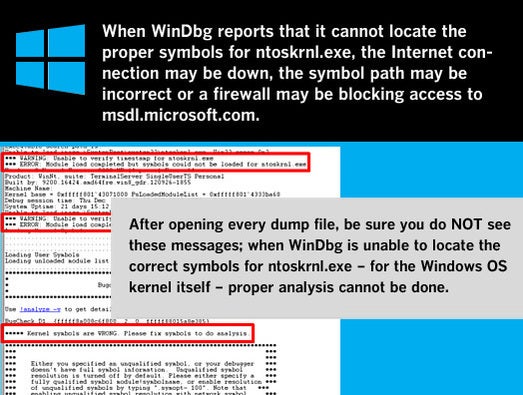-->
Symbol Path
Would you like LiveKd to set the NTSYMBOLPATH directory to reference the Microsoft symbol server so that symbols can be obtained automatically? (y/n) y Enter the folder to which symbols download (default is c: symbols): c: symbols Could not resolve symbols for ntoskrnl.exe: MmPfnDatabase Ensure that your symbol path is correctly configured. Livekd problem with ntoskrnl.exe symbols. Download Eyeshield 21 Sub Indo Mp4 Solidfiles on this page. 'Could not resolve symbols for ntoskrnl.exe. I don't know why livekd is failing to resolve the symbols. Well, seems like my symbols for ntoskrnl.exe somehow got corrupted or went invalid.
The symbol path specifies the directories where the symbol files are located. For more information about symbols and symbol files, see Symbols.
Note If you are connected to the Internet or a corporate network, the most efficient way to access symbols is to use a symbol server. You can use a symbol server by using the srv* or symsrv* string within your symbol path. For more information about symbol servers, see Symbol Stores and Symbol Servers.

To control the symbol path in WinDbg, do one of the following:
Choose Symbol File Path from the File menu or press CTRL+S.
Use the .sympath (Set Symbol Path) command. If you are using a symbol server, the .symfix (Set Symbol Store Path) command is similar to .sympath but saves you typing.
When you start the debugger, use the -y command-line option. See WinDbg Command-Line Options.
Before you start the debugger, use the _NT_SYMBOL_PATH and _NT_ALT_SYMBOL_PATH environment variables to set the path. The symbol path is created by appending _NT_SYMBOL_PATH after _NT_ALT_SYMBOL_PATH. (Typically, the path is set through the _NT_SYMBOL_PATH. However, you might want to use _NT_ALT_SYMBOL_PATH to override these settings in special cases, such as when you have private versions of shared symbol files.) If you try to add an invalid directory through these environment variables, the debugger ignores this directory.
Note If you use the -sins command-line option, the debugger ignores the symbol path environment variable.
Executable Image Path
An executable file is a binary file that the processor can run. These files typically have the .exe, .dll, or .sys file name extension. Executable files are also known as modules, especially when executable files are described as units of a larger application. Before the Windows operating system runs an executable file, it loads it into memory. The copy of the executable file in memory is called the executable image or the image.
Note These terms are sometimes used imprecisely. For example, some documents might use 'image' for the actual file on the disk. Also, the Windows kernel and HAL have special module names. For example, the nt module corresponds to the Ntoskrnl.exe file.
The executable image path specifies the directories that the binary executable files are located in.
In most situations, the debugger knows the location of the executable files, so you do not have to set the path for this file.
However, there are situations when this path is required. For example, kernel-mode small memory dump files do not contain all of the executable files that exist in memory at the time of a stop error (that is, a crash). Similarly, user-mode minidump files do not contain the application binaries. If you set the path of the executable files, the debugger can find these binary files.
The debugger's executable image path is a string that consists of multiple directory paths, separated by semicolons. Relative paths are supported. However, unless you always start the debugger from the same directory, you should add a drive letter or a network share before each path. Network shares are also supported. The debugger searches the executable image path recursively. That is, the debugger searches the subdirectories of each directory that is listed in this path.
To control the executable image path in WinDbg, do one of the following:
Livekd Could Not Resolve Symbols For Ntoskrnl.exe 10
Choose Image File Path from the File menu, or press CTRL+I.
Use the .exepath (Set Executable Path) command.
When you start the debugger, use the -i command-line option. See WinDbg Command-Line Options.
Before you start the debugger, use the _NT_EXECUTABLE_IMAGE_PATH environment variable to set the path.
Note If you use the -sins command-line option, the debugger ignores the executable image path environment variable.